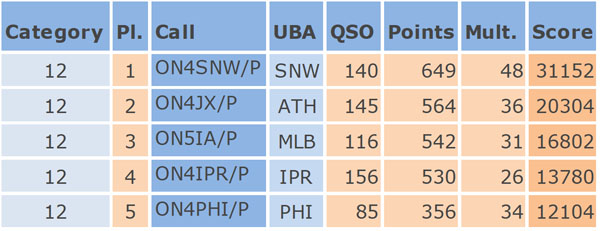CQ field day, CQ field day, this is ON5IA/P.
The proof of the pudding is in the eating, as they say, so what better way to test the Automatic Magnetic Loop Tuner than to participate in a field day?
The weather forecasts looked promising so I decided to subscribe myself for the Region 1 SSB field day of September 2017. The rules for the field day are simple: you’ll have to set up a portable station, and you can only start with the setup 24 hours before the beginning of the contest. In our case, we didn’t even need that much time. One hour before the contest, we unloaded the magnetic loops and installed them. A thick plastic tube was hammered in the grass, and the magnetic loop foot was shoved into it. We attached the coax- and the stepper motor steering-cable, hooked them to the radio, attached the batteries and we were QRV. There were still 30 minutes left before the start of the contest.
After configuring the automatic magnetic loop tuner, we still had 25 minutes left HI HI.
As we wanted to test the automatic tuning capabilities of our tuner, we actually never called CQ. Fixing yourself to one frequency and calling CQ for an hour will not learn you anything with regards to the automatic tuning possibilities, of the loop controller. Instead, we started at the bottom of the band and scrolled up until we reached the first OM calling CQ. When the contact was made and the signal report and numbers were exchanged, we moved to the next OM. When we reached the top of the band, we scrolled down again and picked all the stations we didn’t hear the first pass.
As time passed, band conditions changed. When we moved up and down twice, we switched band. We applied the same tactics on each band. It’s not a great contest tactic, but we did not participate in the field day to win the first price but to test our automatic magnetic loop tuner. The tuner did a fabulous job. We only had a hiccup once, when the mechanical coupling between the stepper motor and the capacitor broke loose.
We subscribed to the 12 hours open all band category, so we were obliged to take our times off. Here again, we didn’t plan them tactically to win the contest but to strengthen our inner man. We had a tasty BBQ and a great sleep. Next day we continued our testing. When we reached 120 contacts our pre-printed logbook was full and we called it a day. 45 minutes later, everything was packed as if the field day never took place.
When I entered the log, it became clear we were short in the number of QSO and multipliers. We ended up on the 5th place of five…
But these were only the claimed scores!
When the final results were known, we moved up two places to the 3rd place. Yeah, that’s a bronze medal.
I found it remarkable that some stations lost so many claimed QSO’s so I started to calculate the ratio between claimed and final scores.
BOOOM, the gold medal for ON5IA/P!
With correctness of 96,67%, we had the best claimed/final-ratio. This can be understood in two ways: 1 we are superb operators, or 2 our magnetic loop antennas gave us the big advantage of having less QRM and better readability.
Let’s assume the second option 😉
This test made me conclude that the magnetic loop antenna is indeed a very good antenna if you don’t have a lot of space in your garden to put up a big tower, or if you live in an environment with a lot of QRM. You can have as much fun as all other OM’s and you don’t even need to skip the contests. That is if you have a solution for the biggest drawback of the magnetic loop antenna: it’s small bandwidth due to the high Q factor. And we have this solution: the automatic magnetic loop tuner!
